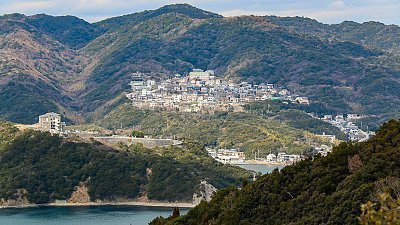Okunoshima Island

In this episode of Far Flung, we head to a more well-known island and considerably fun island in the Seto Inland Sea: Okunoshima Island, more popularly known as Rabbit Island. The small island has a circumference of about 4.3 kilometers and takes about an hour to circle on foot. Overrun by rabbits, Okunoshima provides animal lovers plenty of opportunity to feed and interact with the furry mammals.

My initial distorted image of Okunoshima before going was one where rabbits covered almost every inch of the ground, i.e. rabbits and more rabbits everywhere, and visitors being swarmed by furry bunnies upon arrival. If that is your mental image as well, may I suggest to temper your expectations a little bit and perhaps take away about a thousand rabbits, then a few thousand more until you can see more ground than rabbits. That said, there are still plenty of rabbits - about 1000 of them on the island - just not the millions I was expecting.



Okunoshima can only be accessed by ferry and once on the island, there is not much to do except to walk around and feed the rabbits. The island can be covered comfortably on foot and walking trails lead around and into the interior of the island. However depending on weather conditions, trails into the interior may be closed for safety reasons.




A little bit of background on the island: during the Sino-Japanese War in the middle of the Meiji Period (1868 - 1912), a number of forts were constructed on Okunoshima as strongholds to protect the Seto Inland Sea. However these batteries were never used and some of them can still be seen today. You would think that the island would've been abandoned to nature after the war, but there's more to the story.




Okunoshima Island's history took a dark turn and even saw the island disappearing off maps for a while. Between 1929 to 1945, the Japanese government manufactured poisonous gases on Okunoshima. The island was chosen for its isolated location and hence its conduciveness to secrecy. It remains unknown what role these poisonous gases played in the wars during that period. Okunoshima's dark past remained a secret that only former related military servicemen knew about until 1984 when that information was released to the public.
At the Poison Gas Museum, visitors can see the minimal protective gear workers wore in the form of rubber suits, gloves and boots which were not completely airtight and allowed poisonous material to seep in. Many of the workers developed various afflictions and diseases due to exposure, for some the sickness developed many years after, and of which there were no cure. The museum also displays the equipment used to manufacture the gases and gives an overview of the history of the island during that time. Note that there is limited English at the museum.


In addition to the battery remains, visitors can also see remains of the different parts of the poisonous gas manufacturing plant scattered across the island. All these abandoned remains make Okunoshima a prime location for urban exploration or haikyo as it is known in Japanese. Be aware that haikyo in Japan is often an illegal activity and usually dangerous, and it is better to stay on the right side of the "Do Not Enter" signs.




Back to the cute rabbit island, I circled the entire island, fed a bunch of rabbits, got chased and surrounded by more rabbits, and visited the museum and a few ruins open to the public in about three hours. There are no shops on the small island with the exception of a couple of restaurants at the accommodation site Kyukamura Okunoshima at the southern end. Visitors who want to feed the rabbits can buy rabbit feed from the shop near the ferry terminal on the mainland.





Overall, Okunoshima is an easy short trip out from Hiroshima or a longer trip out if combined with the nearby Onomichi. The rabbits were incredibly friendly and completely tame, and would often hop up to humans to beg for food. There are rules regarding appropriate behaviour to the rabbits to be observed on the island which can be seen in the shop on the mainland, at the ferry terminals, in the ferry and at several points on the island. It is imperative to follow those rules to protect the island and rabbits for future visitors.





Getting There and Around

As of the time of writing, operation of the JR Kure Line was interrupted due to torrential rain in July. This suspension of regular service is expected to be back to normal by January 2019. In the meantime, temporary JR buses provide access between Mihara Station, a stop on the Sanyo Shinkansen (about 25 minutes from Hiroshima), and Tadanoumi Station. The one way bus journey takes about 30 minutes and costs 320 yen, with one departure every 1-2 hours. The fare on the JR bus is covered by the Japan Rail Pass.
The ferry terminal to Okunoshima can be reached in a short walk from Tadanoumi Station on the JR Kure Line. There are approximately hourly ferry departures between Tadanoumi Port and Okunoshima. It is advisable to check the official website for the ferry schedules. The one way journey takes about 15 minutes and costs 310 yen.
When train service on the JR Kure Line is back up and running: From Mihara Station, change to the local line for Tadanoumi Station. The one way journey takes about 20 minutes and costs 320 yen. The train journey is covered by the Japan Rail Pass.




